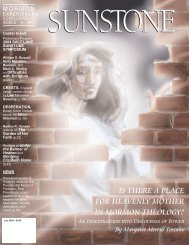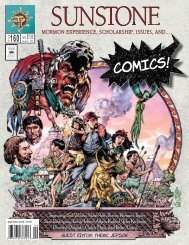Download Entire Issue PDF - Sunstone Magazine
Download Entire Issue PDF - Sunstone Magazine
Download Entire Issue PDF - Sunstone Magazine
You also want an ePaper? Increase the reach of your titles
YUMPU automatically turns print PDFs into web optimized ePapers that Google loves.
S U N S T O N E<br />
by challenging certain orthodoxies.<br />
The last time I met with Duff was in the<br />
lobby of the Joseph Smith Building (formerly<br />
Hotel Utah). He was well past retirement<br />
and showing signs of age. He told me<br />
of many of his experiences with other<br />
Church authorities, remarking that in the<br />
years before blacks had been given full fellowship<br />
in the Church, many of his Church<br />
colleagues had struggled as he had with this<br />
gross inequity, hoping and praying for its<br />
resolution. He described the deep personal<br />
satisfaction he’d felt at being able to represent<br />
the Lord in many places, under a wide<br />
range of circumstances, to diverse people of<br />
all races, social strata, nations, and religious<br />
persuasions.<br />
As we parted, I had the temerity to ask<br />
him why, in his view and considering his<br />
great influence and longevity as a general<br />
authority, he had not risen to a more prominent<br />
Church position. He smiled, and<br />
mildly chastened me with a statement that<br />
“one serves in the Lord’s Church where and<br />
when one is called, and for long as one is<br />
called.”<br />
Then, after a pause, and with a twinkle<br />
in his eye, he ventured that the Lord had<br />
not selected him for further advancement<br />
because “He knew me too well and loved<br />
me too much.” I do not know whether it<br />
was the Lord who chose not to elevate Duff<br />
in this mortal context, but I am certain to<br />
my core that among those who are chosen<br />
to be known and loved by the Lord, Marion<br />
Duff Hanks is among the first.<br />
CHIEKO NISHIMURA OKAZAKI<br />
Coming Home<br />
by Paula Jensen Goodfellow<br />
PAULA JENSEN GOODFELLOW, one of the<br />
founding mothers of the DAM Women Retreat<br />
(www.rockymountainretreat.org), recently<br />
completed an MA in speech-language<br />
pathology. If Mormon tchotchke makers sold<br />
bracelets that read “WWCD” (What would<br />
Chieko do?), Paula would totally buy one<br />
I<br />
N THE EARLY 1990’s, I lived in<br />
Westminster, Colorado, a suburb of<br />
Denver. In those dark days of dial-up<br />
modems and primitive web browsers, we<br />
felt relatively isolated from events in Utah.<br />
Despite this disconnection, I began to hear<br />
news from friends about the new Relief<br />
Society presidency. They were feisty, independent,<br />
well-educated women. My friend<br />
in New Mexico said that Sister Okazaki, the<br />
new first counselor, had visited her stake<br />
and that she was an incredibly strong<br />
speaker with a very personable manner.<br />
A few months later, I heard that Sister<br />
Okazaki was coming to our stake. I was<br />
sure there would be a big crowd, so I arrived<br />
early. Very early. Early enough that I<br />
actually crashed the leadership meeting before<br />
the main meeting.<br />
I saw Chieko standing at the pulpit: a<br />
tiny woman wearing a simple fuchsia dress.<br />
During the question and answer session, it<br />
became clear that her outward appearance<br />
masked an intelligent, caring, and strong<br />
woman. When male leaders asked questions,<br />
she didn’t use the cloying, highpitched,<br />
unsure Relief Society voice; she<br />
didn’t defer to them. Instead she told the<br />
leaders directly, clearly, and strongly what<br />
they should do. When a Relief Society president<br />
asked for guidance on working with<br />
her bishopric, Sister Okazaki told the<br />
woman to go back to her leaders and tell<br />
them what she needed from them and to<br />
explain how it should be done.<br />
At one point during the main meeting, I<br />
was startled and pleased to realize that she<br />
was quoting from Exponent II. And as she<br />
spoke, she leaned forward, gripping the<br />
podium, stating her message forcefully. Her<br />
talk was grounded in the teachings of Jesus,<br />
emphasizing kindness and love. She urged<br />
us to not be so hard on ourselves. She was<br />
pleased with us as we were.<br />
Listening to this woman speak, I felt as<br />
if—having been trapped for many years on<br />
another planet—I had finally received the<br />
message that it was time to come home. I<br />
felt more hope for women in the Church<br />
that day than ever before.<br />
A few years later, she came to the Rocky<br />
Mountain Retreat for LDS Women.<br />
Although she was there as the keynote<br />
speaker, she didn’t hold herself apart from<br />
the rest of us. I saw her spending hours<br />
talking with the women there, listening to<br />
them, and sharing her own opinions.<br />
Sister Okazaki made the Church a better<br />
place because she was not submissive and<br />
deferential but took herself seriously as a<br />
daughter of God. She amplified her talents<br />
much as did the faithful servant in Jesus’s<br />
parable. Here’s to many more Mormon<br />
women like her.<br />
Breaking Free of<br />
Cookie-Cutter<br />
Mormonism<br />
by Mary Ellen Robertson<br />
MARY ELLEN ROBERTSON is <strong>Sunstone</strong>’s director<br />
of outreach and symposia and was the<br />
first LDS woman to complete the women’s<br />
studies in religion MA program at Claremont<br />
Graduate School.<br />
C<br />
HIEKO OKAZAKI’S SEVEN-YEAR<br />
tenure in the General Relief Society<br />
Presidency (March 1990–April 1997) coincided<br />
with my progress into adulthood—<br />
my last two years of college, my<br />
post-graduation wanderings, my acceptance<br />
into Claremont Graduate School’s<br />
women’s studies in religion program, connecting<br />
with like-minded Mormons via<br />
email lists, and figuring out life as a single<br />
LDS woman.<br />
Chieko’s talks were always a highlight in<br />
general conference—engaging, instructive,<br />
and, for me, the equivalent of a window<br />
being thrown open to air a stuffy room.<br />
Likewise, her books were a source of inspiration<br />
and instruction, liberally seasoned<br />
with humor, grace, and realness.<br />
Six months after her release from the<br />
General Relief Society Presidency, Chieko<br />
spoke at a four-stake women’s conference in<br />
Pasadena, California. This was my first and<br />
only experience hearing Chieko speak<br />
live—and uncorrelated. The chapel and<br />
cultural hall were packed with women<br />
eager to hear her.<br />
The conference theme was “Discover<br />
the Joy,” based on D&C 42:61: “If thou<br />
OCTOBER 2011 PAGE 83

















